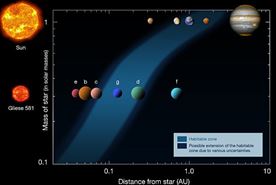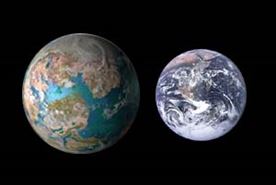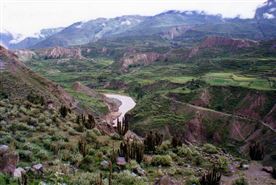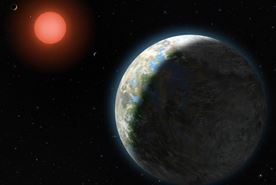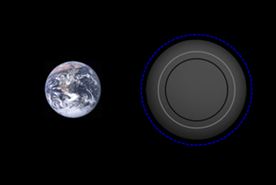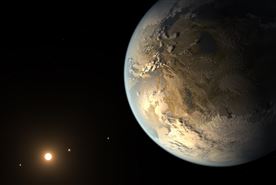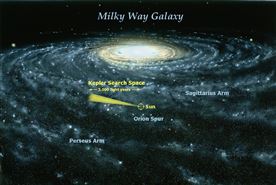YOLA 07A: A New Planet Is Discovered - all
Adjective
coming from or existing outside the planet Earth
extra-terrestrial
Humans have long been fascinated by the possibility of extra-terrestrial life. Novels, films, and folk tales have encouraged curiosity and speculation about what might be 'out there' in space.
Humans have long been fascinated by the possibility of extra-terrestrial life. Novels, films, and folk tales have encouraged curiosity and speculation about what might be 'out there' in space.
Noun
the basic structures that are needed for something to function properly
infrastructure
Gliese 581c skims the near side of the habitable zone, but scientists suggest that it does not have enough of a toehold in this zone to provide a stable infrastructure for organic formations.
Gliese 581c skims the near side of the habitable zone, but scientists suggest that it does not have enough of a toehold in this zone to provide a stable infrastructure for organic formations.
Noun
a feeling of being surprised or amazed
wonderment
More recently, scientists have joined in on the collective wonderment after the first discovery by astronomers of a new planet - Gliese 581g - that could almost certainly support extra-terrestrial organisms.
More recently, scientists have joined in on the collective wonderment after the first discovery by astronomers of a new planet - Gliese 581g - that could almost certainly support extra-terrestrial organisms.
Verb
to give honor or recognition to someone for doing something or for making something happen
credited
Steven Vogt - one of the two astronomers credited with discovering Gliese 581g - has declared that 'the chances of life on this planet are 100 per cent' and that he has 'almost no doubt about it'.
Steven Vogt - one of the two astronomers credited with discovering Gliese 581g - has declared that 'the chances of life on this planet are 100 per cent' and that he has 'almost no doubt about it'.
Verb
to provide what is needed for something or someone to exist, continue, etc.
sustain
Firstly, Gliese 581g is located at almost exactly the right distance from its red dwarf parent star (Gliese 581) in order to sustain liquid water, which is the only known criterion for organic formation.
Firstly, Gliese 581g is located at almost exactly the right distance from its red dwarf parent star (Gliese 581) in order to sustain liquid water, which is the only known criterion for organic formation.
Verb
to say that (something) is larger or greater than it really is
overstated
The comparisons between the Earth and Gliese 581g should not be overstated, however. Even if Gliese 581g can sustain organisms, it would be a very different place to live.
The comparisons between the Earth and Gliese 581g should not be overstated, however. Even if Gliese 581g can sustain organisms, it would be a very different place to live.
Noun
the force of attraction that bodies exert on one another as a result of their mass
gravitational pulls
Because Gliese 581 is only 1% as bright as the Sun, it exudes little warmth, and its habitable zone lies much closer. At this distance, planets get locked into strong gravitational pulls that tend to slow their rotation.
Because Gliese 581 is only 1% as bright as the Sun, it exudes little warmth, and its habitable zone lies much closer. At this distance, planets get locked into strong gravitational pulls that tend to slow their rotation.
Adjective
having the qualities that are right, needed, or appropriate for something
suitable
Planets that orbit too close to or too far away from their stars do not have a suitable climate; this can only be found in a slender strip of solar space around each star known to astronomers as a 'habitable zone'.
Planets that orbit too close to or too far away from their stars do not have a suitable climate; this can only be found in a slender strip of solar space around each star known to astronomers as a 'habitable zone'.
Verb
not safe or suitable to be lived in
uninhabitable
Planets that grow beyond 10 times the size of the Earth tend to become gaseous and uninhabitable, without the solid or liquid infrastructure necessary for organisms.
Planets that grow beyond 10 times the size of the Earth tend to become gaseous and uninhabitable, without the solid or liquid infrastructure necessary for organisms.
Adjective
very great in number, effect, or force
overwhelming
Even at 10%, the high possibility of life is overwhelming. There are at least a few hundred billion stars in our galaxy, which means that around 20 to 40 billion planets have the potential for the development of organisms.
Even at 10%, the high possibility of life is overwhelming. There are at least a few hundred billion stars in our galaxy, which means that around 20 to 40 billion planets have the potential for the development of organisms.
Noun
the group of colors that a ray of light can be separated into
spectrum
The next step in finding out the chances of life on the planet would be to measure its light spectrum, a process that would reveal molecular oxygen if it exists. The glare from Gliese 581 makes this impossible, however.
The next step in finding out the chances of life on the planet would be to measure its light spectrum, a process that would reveal molecular oxygen if it exists. The glare from Gliese 581 makes this impossible, however.
Noun
a unit of distance equal to the distance that light travels in one year
light years
Another way to gather information would be to transport a vessel to and from the planet. The technology exists to do this, but at 20 light years from the Earth, it would take 200 years for astronomers to receive the result.
Another way to gather information would be to transport a vessel to and from the planet. The technology exists to do this, but at 20 light years from the Earth, it would take 200 years for astronomers to receive the result.





